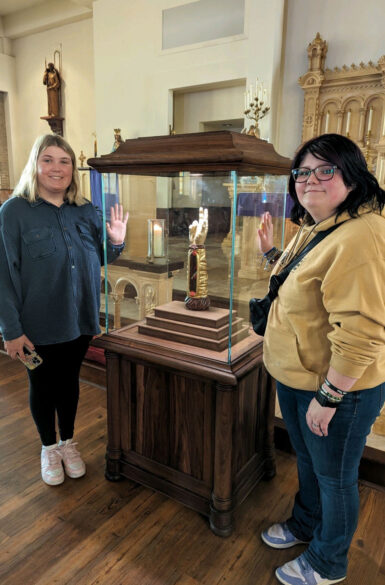
FEATURED PHOTO … Relic of St. Jude…


PARISH, FAMILY & SCHOOL EVENTS
CLEVELAND – Our Lady of Victories, Sunday, May 19, Parish Picnic, including cookout and games for the whole family. Details: church office (662) 846-6273.
COLUMBUS – Annunciation School, Production of “Peter Pan” by middle school students, April 25 at 6:30 p.m. and April 26 at 9:30 a.m. and 6:30 p.m. Cost: $5 adults; $3 students (3-18 years); under three years old – free. The 9:30 a.m. showing on April 26 is free and open to the public. Details: school office (662) 328-3379.
GLUCKSTADT – St. Joseph, Charity Tea, Saturday, April 20 at 2 p.m. in the parish hall. Cost: adults $25; children 10 and under $15. Tickets available after Mass on April 13 and 14. Limited number available. Details: church office (601) 856-2054.
JACKSON – St. Richard School, Flight to the Finish 5k and Fun Run, Saturday, April 20 at 9 a.m. Details: Visit website for more info and to register at https://runsignup.com/Race/MS/Jackson/FlighttotheFinish. To sponsor visit https://bit.ly/FlighttoFinish.
JACKSON – Sister Thea Bowman School, Annual Draw Down, Saturday, April 27 at 6:30 p.m. in the multi-purpose building. Grand prize $5,000; tickets $100 (admits 2), second chance insurance $20. Enjoy great food, entertainment, silent auction, door prizes and more. Casual attire. Details: contact Shae at (601) 351-5197 or stbdrawdown@gmail.com.
JACKSON – Capitol building, Working Together Mississippi Rally for Full Medicaid Expansion, Tuesday, April 16 from 9 a.m. to 2:30 p.m. To see the full schedule and register to attend visit: https://bit.ly/3U8yFOv.
MADISON – St. Francis, Save the dates: Vacation Bible School – June 17-20; Cajun Fest – Sunday, May 19.
MADISON – St. Joseph School, “Bruin Burn” 5k Run/Walk and fun run, May 11 at 8 a.m. Early bird registration $25 for 5k or $10 for fun run through April 25. Register at https://raceroster.com/events/2024/87878/bruin-burn. Details: email bruinburn@gmail.com.
NATCHEZ – St. Mary Basilica, Blood Drive, Tuesday, April 16, from 12:45-5:45 p.m. at the Family Life Center. Details: church office (601) 445-5616.
St. Mary Basilica, Life Line Screening, Friday, April 19 at the Family Life Center. Advanced ultrasound technology looks inside your arteries for signs of plaque buildup. To register for an appointment and receive a special discount, call 1-800-640-6307 or visit llsa.social/hc.
NATCHEZ – Cathedral School, Cajun Countdown, Friday, May 3. Details: eks_46@yahoo.com or sarahc@terralriverservice.com.
PEARL – St. Jude, Spring Fair, Saturday, May 4 from 10 a.m. to 4 p.m. in the parish hall. This free event will feature a variety of handmade items, homemade food, raffle and more. All proceeds will benefit the St. Jude’s Artisan Guild ministry. Details: church office (601) 939-3181.
SENATOBIA – St. Gregory, Youth United for Christ Spring Fun Event, Sunday, April 21, begins with Mass at 3 p.m. Join youth from the six parishes of Northwest Mississippi for a fun day of sports, games and prizes. Snacks and dinner provided. Details: (662) 562-5318.
SPIRITUAL ENRICHMENT
NATCHEZ – 2nd annual Believe Conference, April 19-21, 2024. Featured speakers are Anne Trufant, Catholic speaker and founder of The Mission on the Mountain; Barbara Heil, founder of From His Heart Ministries; and Joanne Moody, minister author, and founder of Agape Freedom Fighters. Cost: $100 for weekend; $50 for students. Lunch included on Saturday. Details: visit https://www.themissiononthemountain.com.
NEW ORLEANS – Directed Retreat with the Archdiocesan Spirituality Center at the Cenacle on Lake Pontchartrain, June 28-July 3. Cost $500 –includes lodging, meals and personal spiritual director. To register call (504) 861-3254. Details: for more information call Melinda at (601) 597-7178.
SOUTHAVEN – Christ the King, “Jesus and the Jewish Roots of the Eucharist,” Thursdays, April 18, 25; May 2, 9, 16, 23, 30; and June 6 from 6:30-8 p.m. How do these Jewish roots help us, to understand his real presence in the Eucharist? Facilitator is Don Coker. Details: church office (662) 342-1073.
NOW HIRING
FLOWOOD – St. Paul Early Learning Center is now hiring a director. Ages for the Center cover infants through Pre-K5. Qualifications include bachelors degree in education or similar; experience in early childhood development; spiritual and instructional leadership skills; experience with school finance/budgeting requirements. Must maintain a personal philosophy, values and lifestyle consistent with the tenents of the Catholic faith. Email letter of interest and resume to finance@spaulcc.org.

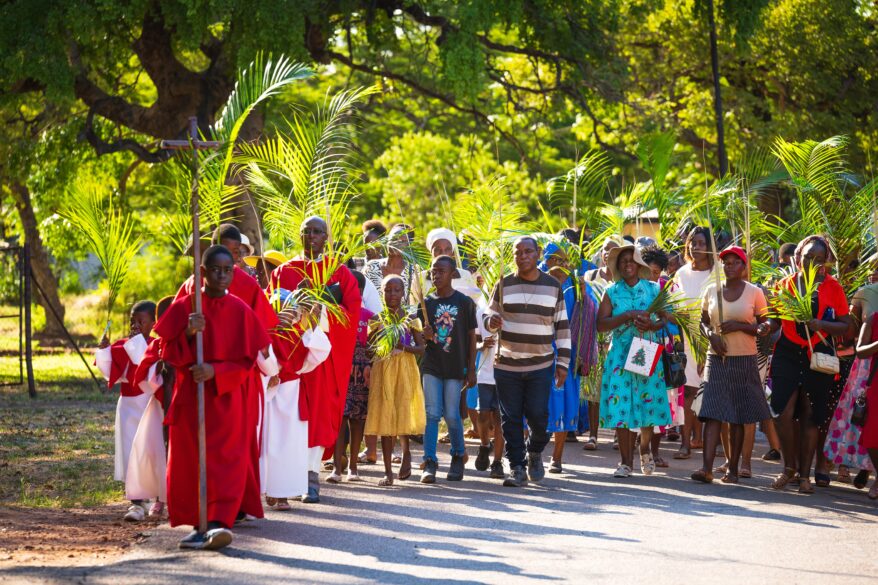
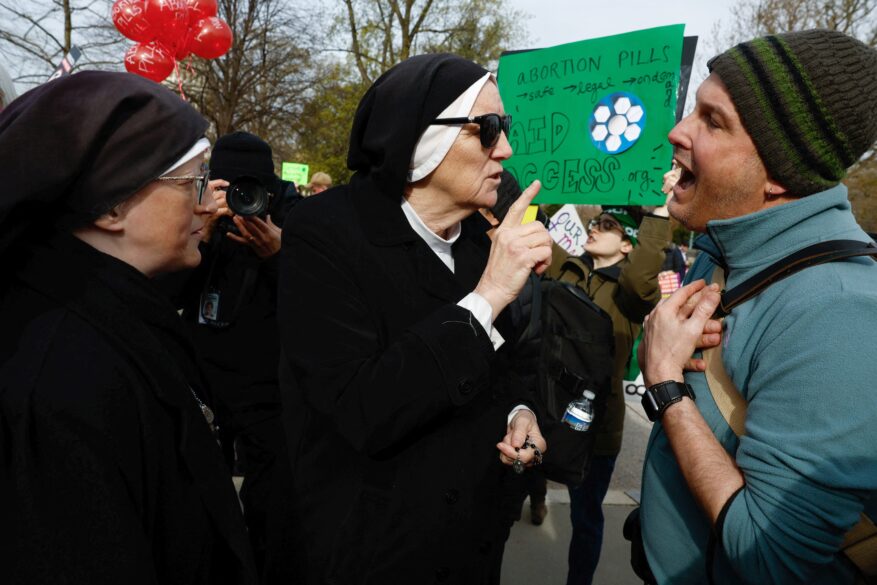
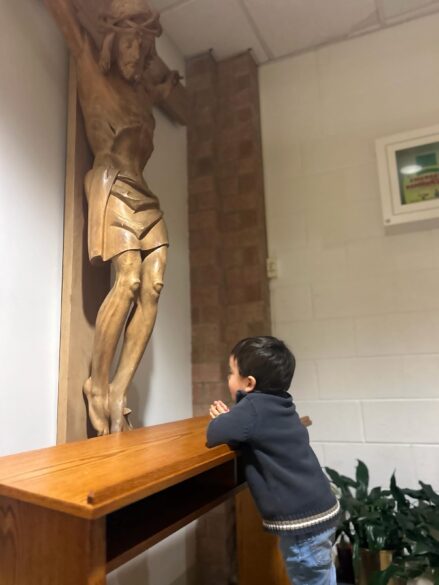
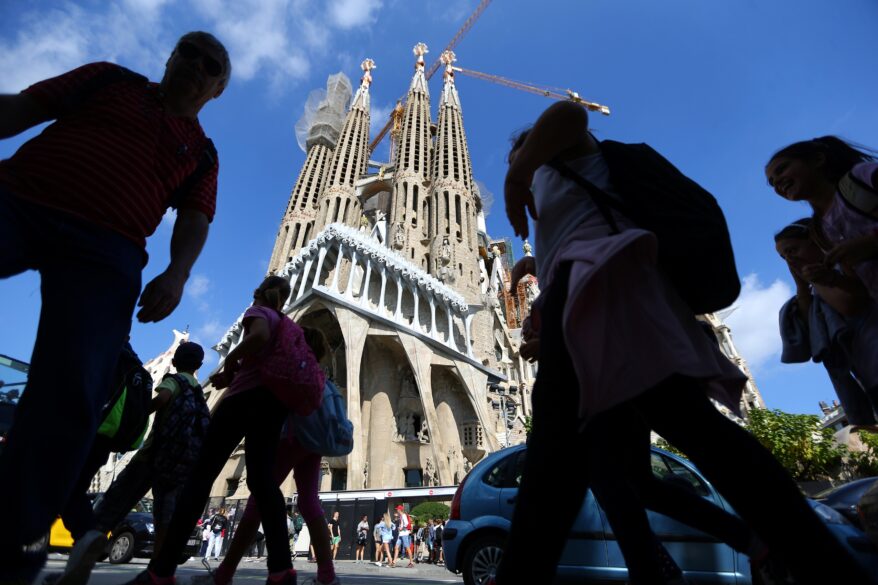

PONTOTOC – La niña Katrina González y decenas más de infantes, niños, jóvenes y adultos disfrutaron de la búsqueda de huevos de Pascua, en la casa de Maria Mares, con la que los parroquianos de San Cristobal terminaron la Semana Santa (Foto de Aracely Nieves)
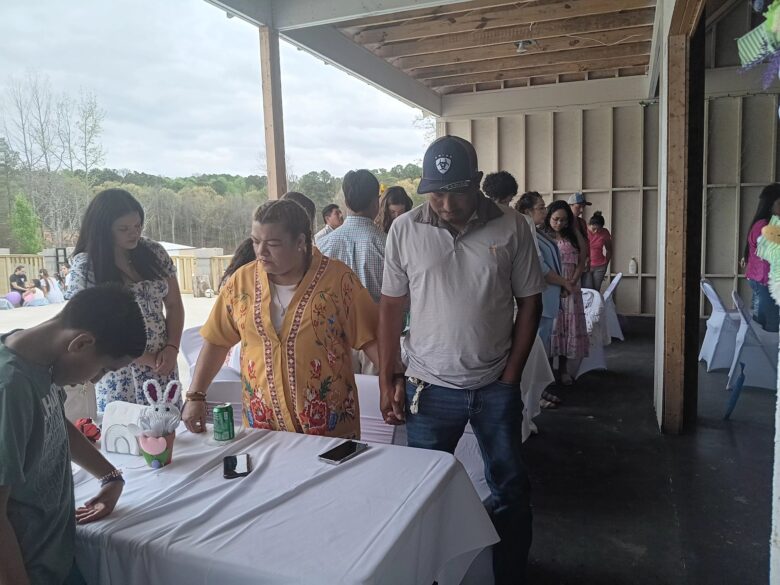
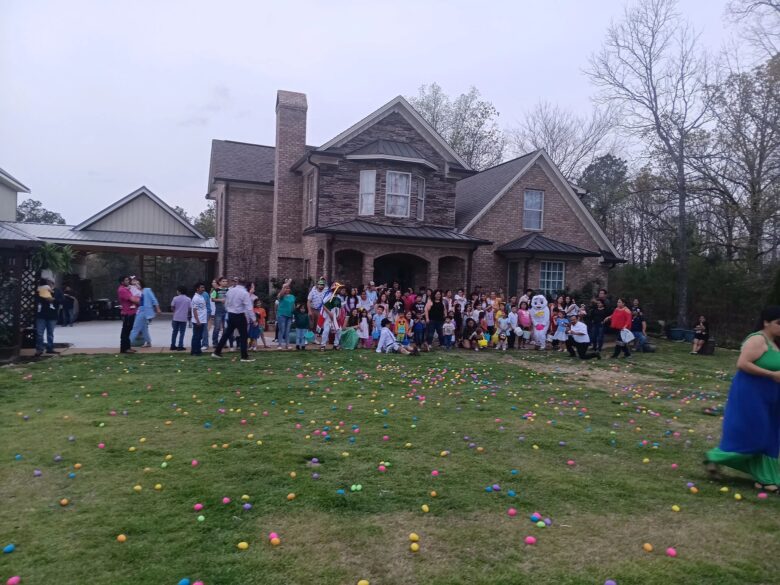
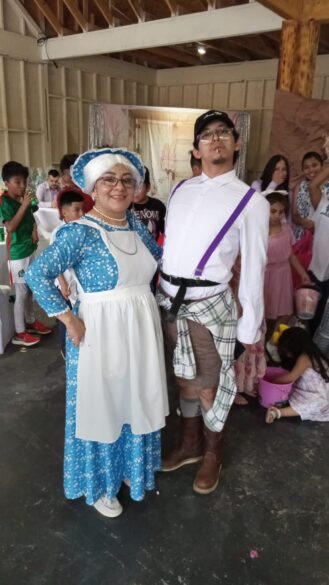

PONTOTOC – La Semana Santa de los parroquianos de San Cristóbal estuvo llena de representaciones, Misas y diversión. La representación, que en medio de la fiesta de Pascua, hicieron Aracely Nieves y un parroquiano, disfrazados de ancianos, tal como se ven en la foto, se basó en el relato de las historias de la Resurrección y la del Conejo de Pascua, con la colaboración de Juanis López, la maestra de los jóvenes de danza, quienes además se disfrazaron como niños traviesos. (Foto de Aracely Nieves)
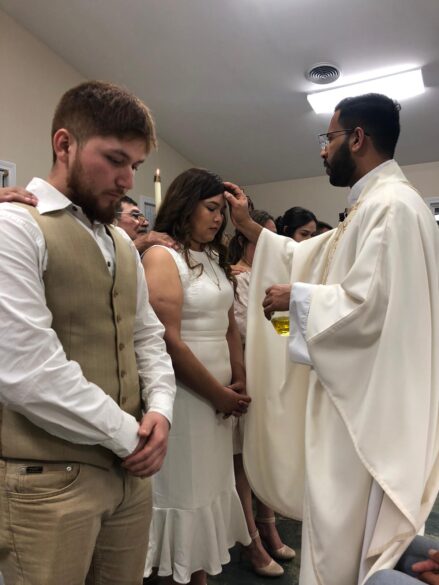
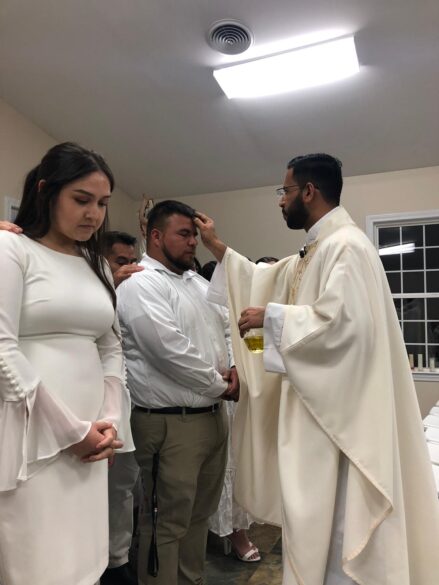
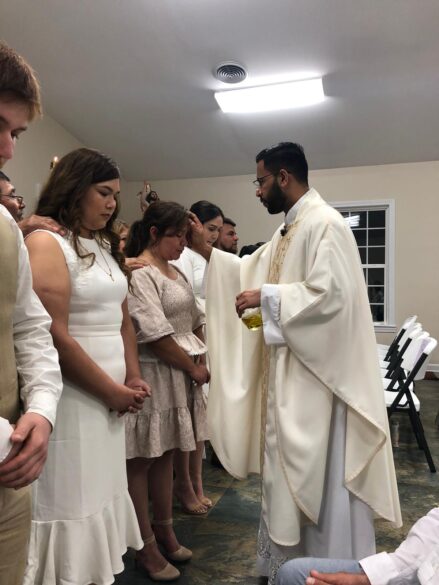
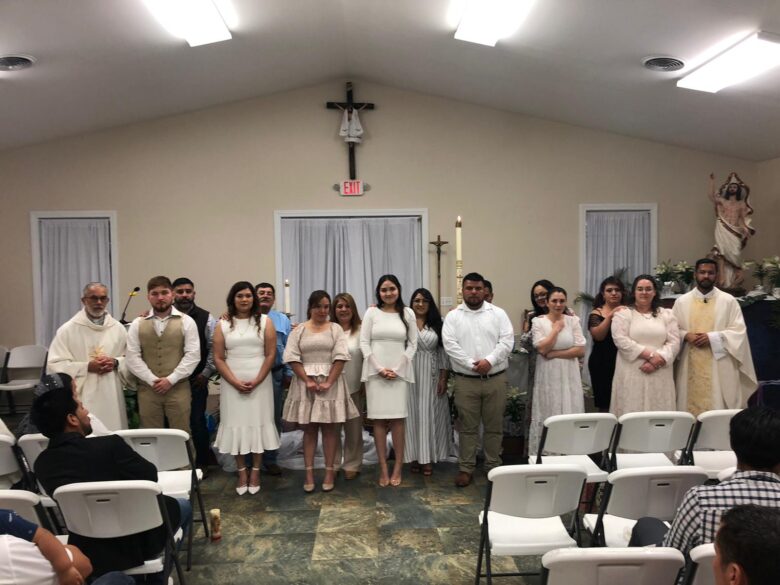
PONTOTOC – Grupo de jóvenes de RICA 2024 de la iglesia St Cristobal recibieron sus sacramentos el sábado de vigilia Pascual, de manos del Padre Justin Joseph y acompañados de sus madrinas y padrinos. El grupo compuesto por Itzel González, Norma Alicia Romero, Dellanira Rodriguez, Ezequiel Martínez, Maricela Martinez, Gina Gonzalez y Carlos Moreno estuvo en las clases de catequesis impartidas por la Hermana Raquel y el Sr. Luis Gordillo Mendoza. (Foto de Luis Gordillo)
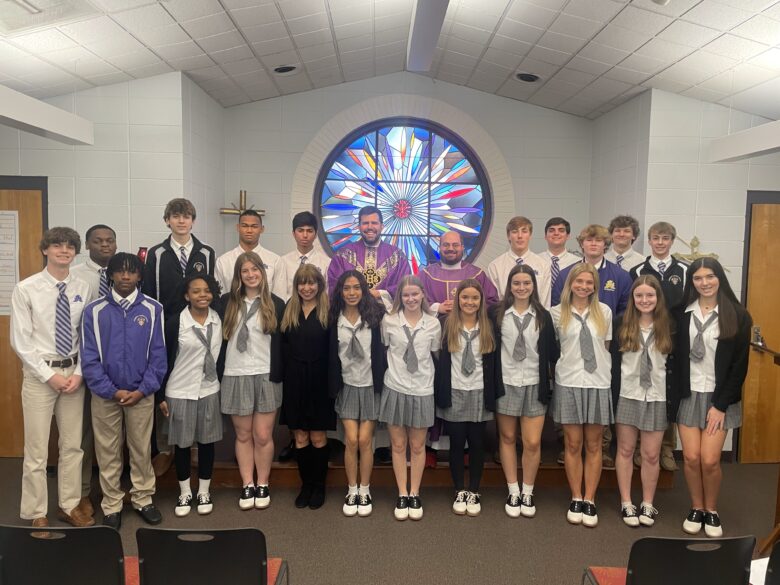
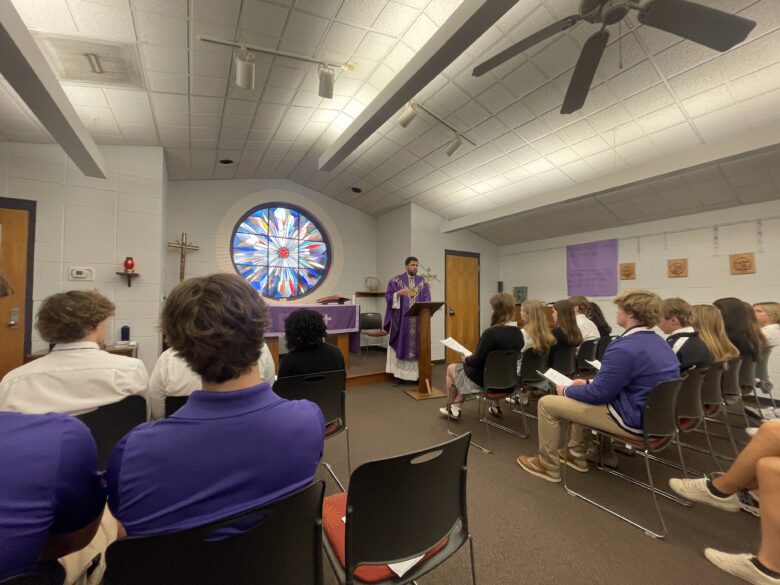
VICKSBURG – El 28 de febrero de 2024, el Padre Nick Adam, acompañado del Padre Rusty Vincent, celebró una Misa en español en la Capilla de San Francisco Javier para la clase de español. Los estudiantes leyeron, respondieron y participaron en español. (Foto de Vivian Velázquez, maestra de Español de Vicksburg Catholic School)
Por Justin McLellan
CIUDAD DEL VATICANO (CNS) – Al igual que Jesús quitó la piedra que sellaba su tumba en la mañana de la Resurrección, en Pascua sólo Cristo “es capaz de quitar las piedras que cierran el camino hacia la vida” y que atrapan a la humanidad en la guerra y la injusticia, dijo el Papa Francisco.
Con su Resurrección, Jesús abre “esas puertas que cerramos continuamente con las guerras que proliferan en el mundo”, dijo tras celebrar la Misa de Pascua en la Plaza de San Pedro el 31 de marzo. “Sólo Cristo resucitado, dándonos el perdón de los pecados, nos abre el camino a un mundo renovado”.
Sentado en el balcón de la Basílica de San Pedro, el Papa rezó pidiendo a Cristo resucitado que traiga la paz a Israel, Palestina y Ucrania, así como a otras muchas regiones del mundo asoladas por conflictos.
“A la vez que invito a respetar de los principios del derecho internacional, hago votos por un intercambio general de todos los prisioneros entre Rusia y Ucrania”, dijo, “¡Todos por todos!”
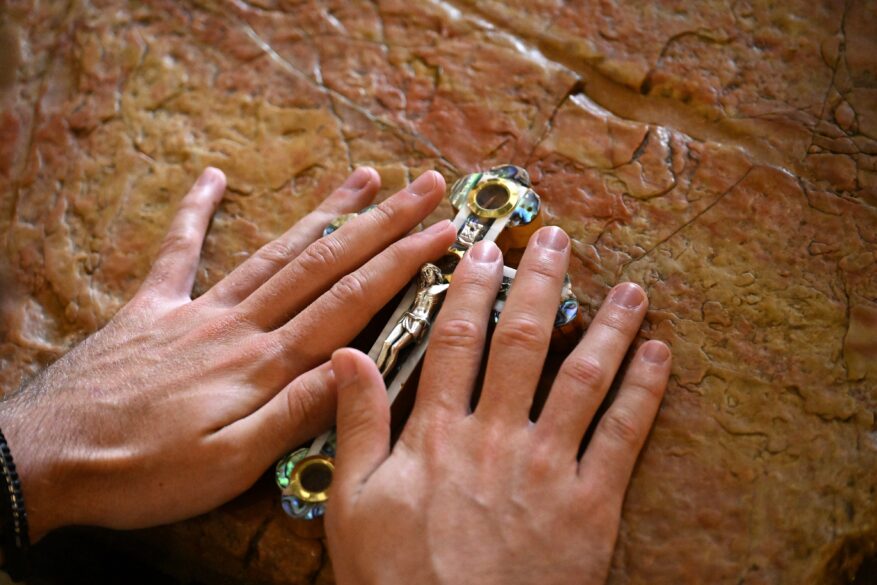
A continuación, el Papa Francisco hizo un llamado a la comunidad internacional para garantizar el acceso de ayudas humanitarias a Gaza y pidió la “rápida liberación” de los rehenes tomados durante el ataque de Hamás a Israel el 7 de octubre, así como “un inmediato alto el fuego en la Franja”.
“La guerra es siempre un absurdo y una derrota”, dijo, pidiendo que los “vientos reforzadores de la guerra” no lleguen a Europa y al Mediterráneo. “No permitamos que los vientos de la guerra soplen cada vez más fuertes sobre Europa y sobre el Mediterráneo. Que no se ceda a la lógica de las armas y del rearme. La paz no se construye nunca con las armas, sino tendiendo la mano y abriendo el corazón”.
La Misa de Pascua en la plaza florida comenzó con el canto del “aleluya”, tradicionalmente ausente de las celebraciones litúrgicas durante la Cuaresma, como parte del rito del “Resurrexit”, en el que se presenta al Papa un icono de Jesús para recordar el testimonio de San Pedro sobre la resurrección de Cristo.
Más de 21.000 bulbos de flores donados por floricultores holandeses decoraban la plaza y hacían estallar de color el cielo encapotado.
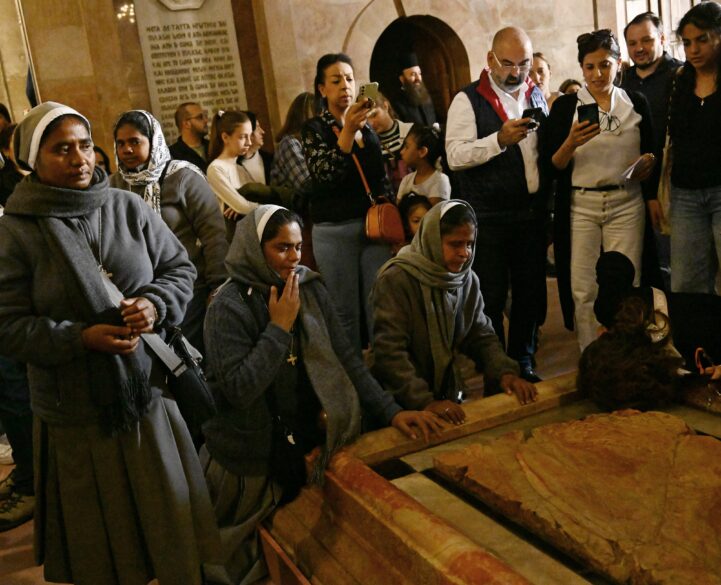
Como es tradicional, el Papa no pronunció una homilía durante la Misa matutina, sino que inclinó la cabeza y observó varios minutos de reflexión silenciosa tras el canto del Evangelio en latín y griego.
“Que Cristo resucitado abra un camino de esperanza a las personas que en otras partes del mundo sufren a causa de la violencia. Que dé consuelo a las víctimas de cualquier forma de terrorismo.”
Por Obispo Joseph R. Kopacz, D.D.
“Por eso, vuélvanse ustedes a Dios y conviértanse, para que él les borre sus pecados 20 y el Señor les mande tiempos de alivio, enviándoles a Jesús, a quien desde el principio había escogido como Mesías para ustedes.” (Hechos de los Apóstoles 3:19-20)
Durante esta temporada de Pascua habrá oportunidades adiciona les, en cada uno de nuestros seis decanatos para promover con nuestro proceso de la Reimaginación Pastoral las conversaciones parroquianas.
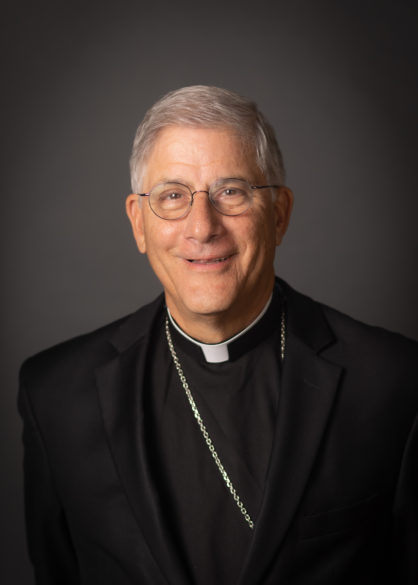
Para aplicar la frase de las Escrituras de San Pedro en el pasaje anterior, otra forma de expresar el objetivo de nuestro proceso es avanzar hacia un tiempo de refrigerio y renovación bajo la mirada de Una, Santa, Católica y Apostólica.
Aunque el proceso se organizó desde el centro diocesano, el trabajo se ha llevado a cabo a nivel local con conversaciones con el fin de reimaginar lo que podría ser, basándose en el compromiso diocesano y mundial de la sinodalidad en la Iglesia Católica.
Debe ser un proceso de base para que el centro diocesano pueda escuchar y conversar auténticamente con todos los puntos cardinales. En otras palabras, “…el que tiene oídos, que oiga lo que el Espíritu dice a las iglesias.” (Apocalipse 2:11 y 3:22) El Señor mismo expresó su potencial espiritual y pastoral “…tienen tapados los oídos y han cerrado sus ojos, para no ver ni oír, para no entender ni volverse a mí, para que yo no los sane.” (Mateo 13:15)
No es sorprendente que la sanación y una mayor unidad fueran un tema repetido durante nuestro proceso sinodal diocesano, tanto para nuestra iglesia como para nuestra sociedad. Otro deseo expresado fue el de una comprensión y aplicación más significativas de la Biblia, la sagrada palabra de Dios. Todo esto se ve y se escucha el Domingo de la Divina Misericordia en las Escrituras, en la Eucaristía y en el rezo de la Coronilla. En la clásica aparición de la resurrección, el Señor se encontraba repentinamente en medio de sus apóstoles dispersos y temerosos e inmediatamente los bendijo con paz, de hecho, tres veces en dos encuentros. Procedió a soplar sobre ellos el poder del Espíritu Santo para el perdón de los pecados, de ellos y de todos los que escucharan el Evangelio y vinieran a la fe. Con la gracia de Dios en abundancia, los envió al mundo para que todos “para que al creer, tengáis vida en su nombre.” (Juan 20:19-31) Este es un relato evangélico de sanación y esperanza después del trauma de la crucifixión violenta, y la división y el conflicto que surgen de tales eventos. Muchos en nuestra sociedad e iglesia se están recuperando de una agitación similar.
En la segunda lectura del Domingo de la Divina Misericordia, en la tradición del discípulo amado Juan, escuchamos que este es el poder “Este es el que vino mediante agua y sangre, Jesucristo; no solo con[g] agua, sino con[h] agua y con[i] sangre. Y el Espíritu es el que da testimonio, porque el Espíritu es la verdad.” (1Juan 5:6) El agua y la sangre, los rayos azules y rojos del costado del Crucificado y Resucitado, la Divina Misericordia. El buen fruto de todo esto se escucha e imagina desde la primera lectura del Domingo de la Divina Misericordia.
“Con gran poder los apóstoles daban testimonio de la resurrección del Señor Jesús[v], y abundante gracia había sobre todos ellos. 34 No había, pues, ningún necesitado entre ellos.” (1 Hechos 4:33-35)
Éste es el paradigma de la comunidad cristiana, fuerte en la fe, la esperanza y el amor, un ideal sin duda, pero también real en muchos niveles. Aunque no se expresó formalmente hasta el año 325 en el Credo de Nicea, está claro que Una, Santa, Católica y Apostólica se estaba desarrollando desde el principio.
El proceso de Reimaginar nuestra diócesis es una esperanza siempre antigua y siempre nueva. “Tarde te he amado, oh Belleza siempre antigua, siempre nueva…” (Confesiones de San Agustín)
Queremos ver, escuchar y comprender el poder de la resurrección del Señor, su paz, su misericordia, su llamado y misión para nuestras vidas, en nuestras parroquias, escuelas y ministerios. En general, la nueva vida del tiempo de Pascua, una temporada de refrigerio, por la gracia de Dios, está produciendo buenos frutos de los esfuerzos de reinventar nuestra diócesis. Sigamos peleando la buena batalla de la fe, “esta es la victoria que ha vencido al mundo: nuestra fe.” (1 Juan 5:4)
Por Manuel Rueda
(OSV News) – Mientras obispos de Colombia, Costa Rica y Panamá visitaban dos campamentos de migrantes en el extremo norte de la selva del Darién, el Papa Francisco calificó el traicionero viaje hacia una vida mejor del migrante como un vía crucis.
La “caravana humana pasa por el Tapón del Darién, una selva que es triunfo de la naturaleza pero que hoy se convierte en un verdadero ‘viacrucis’”, escribió el pontífice en un mensaje del 19 de marzo a los obispos reunidos en Panamá del 19 al 22 de marzo.

El Papa Francisco advirtió que la crisis en el Tapón del Darién “no sólo pone en evidencia los límites de la gobernanza migratoria en el hemisferio occidental, sino alimenta un próspero negocio que permite acumular ganancias ilícitas del tráfico humano”.
La visita a los campamentos de migrantes fue una iniciativa denominada “Pascua con nuestros hermanos migrantes” durante el encuentro de los obispos fronterizos de Colombia y Costa Rica y los obispos de Panamá. Los prelados llamaron a los gobiernos de América Latina a respetar los derechos fundamentales de los migrantes y refugiados que transitan por sus territorios rumbo a Estados Unidos.
En una declaración emitida el 22 de marzo, los líderes de la Iglesia también dijeron que intentarán encontrar formas para que sus diócesis estén más cerca de los migrantes y llamaron a las naciones a donde se dirigen los migrantes a idear políticas públicas que faciliten su desarrollo económico, social e integración cultural y derribar los muros legales físicos y simbólicos que enfrentan millones de migrantes y refugiados.
La declaración de los obispos culminó una reunión en Panamá, donde miembros del clero y funcionarios de Caritas se reunieron para analizar la crisis humanitaria que se está desarrollando en el Tapón del Darién, la densa y sin carreteras jungla que separa América del Sur de Centroamérica.
En 2023, el número de migrantes que cruzan el Darién en su camino hacia Estados Unidos se duplicó: 520.000 personas realizaron el peligroso viaje a través de la selva.
Si bien esta ruta se ha vuelto cada vez más popular para los migrantes de América del Sur, África y Asia, sigue siendo peligrosa y los migrantes que cruzan el Darién están expuestos regularmente a enfermedades tropicales, robos y agresiones sexuales a lo largo de la caminata de tres a cinco días. Decenas de migrantes también se ahogan cada año mientras intentan cruzar los traicioneros ríos de la selva.
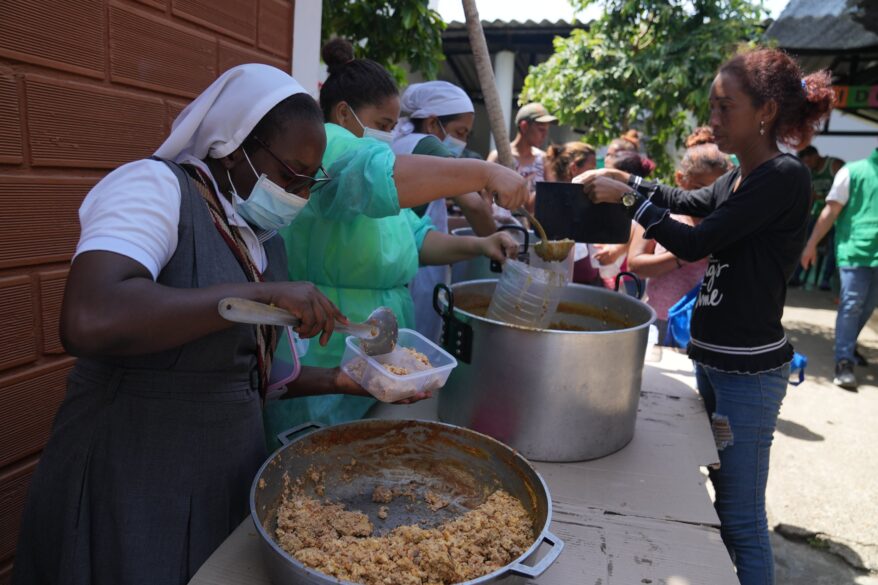
A pesar de estos peligros, Panamá redujo recientemente el apoyo médico a los migrantes que sobreviven la ruta, al suspender las operaciones del grupo médico Médicos Sin Fronteras, conocido por las siglas francesas MSF.
La organización había estado atendiendo hasta 5.000 migrantes por mes en sus puestos de salud en el extremo norte de la selva de Darién, pero perdió el favor del gobierno de Panamá después de emitir un comunicado de prensa en el que afirmaba que los funcionarios estaban permitiendo que grupos criminales entraran por esa región del país para operar “con impunidad”.
“Algunas personas nos dijeron que estaban recibiendo medicinas de la Cruz Roja”, dijo a OSV News Margaret Cargioli, una abogada de derechos humanos que visitó el campamento de Lajas Blancas a principios de marzo. “ Pero lo que parece estar sucediendo es que ha menos apoyo médico”.
En su declaración del 22 de marzo, los obispos de Panamá, Costa Rica y Colombia dijeron que la iglesia necesita aumentar su influencia sobre las políticas que los gobiernos están adoptando hacia los inmigrantes.
“Como Iglesia tenemos un compromiso de incidir políticamente”, dijo el obispo Mario de Jesús Álvarez Gómez de Istmina-Tadó, Colombia. “¿Cómo vamos a hacer eso? Con el Evangelio y la constitución en las manos”.
Los líderes de la Iglesia dijeron que, durante su reunión del 19 al 22 de marzo, también discutieron la posibilidad de crear ministerios para la movilidad humana dentro de sus diócesis, y también consideraron la necesidad de capacitar a los miembros de Cáritas para abordar temas relacionadas con la migración.
“La iglesia tiene como vocación y como esencia acompañar a todo aquel que sufre”, dijo el obispo Daniel Francisco Blanco Méndez de San José, Costa Rica, durante la conferencia de prensa posterior a la visita al Tapón del Darién. “Por eso es necesario que reflexionemos sobre cómo podemos ser más cercanos en medio de estas situaciones de dolor (de migración forzada)” que tantos hermanos y hermanas experimentan.
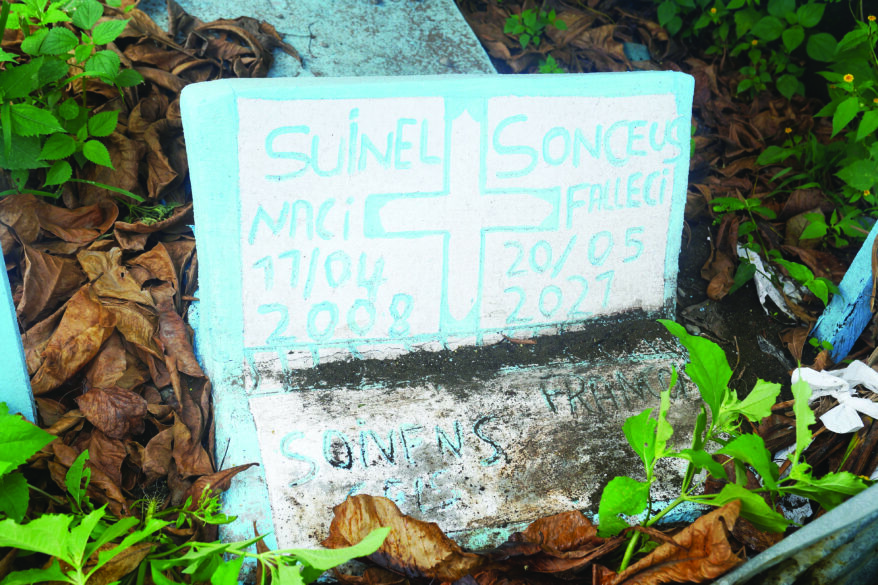
El padre Rafael Castillo Torres, director de Cáritas Colombia, dijo que, si bien los trabajadores de Cáritas en su país tenían “compasión y buena voluntad”, necesitaban una mejor capacitación sobre cómo brindar apoyo legal y humanitario a los migrantes.
El arzobispo José Domingo Ulloa Mendieta de la ciudad de Panamá dijo que establecer servicios de apoyo a los inmigrantes sería un “gran desafío” para las parroquias de su país. Pero los animó a emprender esta tarea.
“Hablar de migrantes también es hablar de nuestra espiritualidad”, afirmó el arzobispo. “Acogiendo a los migrantes estamos ya construyendo la ciudad de Dios y la ciudad del hombre con la justicia y la solidaridad”.
Los obispos también dijeron que el Papa Francisco les había enviado un mensaje a los migrantes y que el nuncio apostólico en Panamá, el arzobispo Dagoberto Campos Salas, lo había leído en el campo de refugiados.
“No se olviden nunca de su dignidad humana”, decía el mensaje. “No tengan miedo de mirar a los demás a los ojos porque no son un descarte, sino que también forman parte de la familia humana y de la familia de los hijos de Dios”.
Los obispos y agentes pastorales, dijo el Papa, son como “la Verónica, con cariño brinda alivio y esperanza en el viacrucis de la migración”, y “el rostro de una madre Iglesia, que marcha con sus hijos e hijas”.
(Manuel Rueda escribe para OSV News desde Bogotá, Colombia.)
Por OSV News
CUERNAVACA, México (OSV News) –Un gran número de católicos acudieron a celebrar la Semana Santa en Nicaragua. Pero el régimen sandinista gobernante prohibió las exhibiciones públicas de fe, como procesiones y recreaciones de la pasión de Cristo, mientras continuaba ejerciendo control sobre las actividades religiosas en lo que se está convirtiendo en un país cada vez más totalitario.
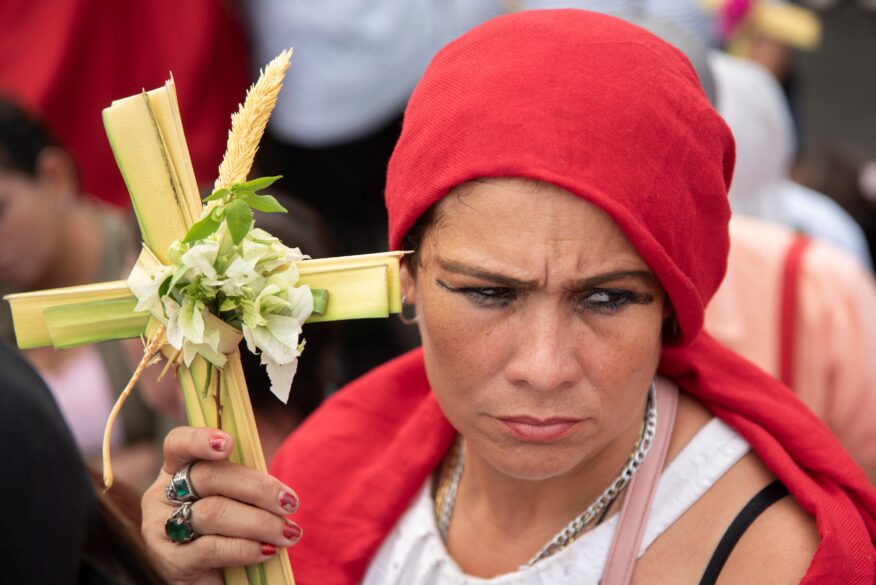
Las procesiones tuvieron lugar dentro de los atrios y santuarios de las iglesias mientras la policía y los paramilitares monitoreaban las actividades en el exterior e incluso fueron capturados filmando los eventos, según cuentas de las redes sociales. Unos 30 agentes de policía acorralaron a los asistentes a la catedral de Managua el Viernes Santo, 29 de marzo, informó el medio de noticias independiente Confidencial, asegurando que no ocurriera nada fuera de la propiedad de la iglesia.
Martha Patricia Molina, una abogada nicaragüense en el exilio que documenta la represión de la iglesia, calculó que durante la Semana Santa se desplegaron unos 4.000 policías y se cancelaron unas 4.800 procesiones. Publicó un vídeo en X de tres estudiantes arrestados simplemente por llevar la imagen de un santo.
“Domingo de Ramos con presencia de policías y paramilitares a lo interno y externo de las parroquias. Tomaban fotos y vídeos a los laicos. Un domingo bajo extremo asedio”, publicó el 24 de marzo.
“Jesús también fue víctima de turbas azuzadas, que lo apresaron violentamente con palos y espadas”, publicó el mismo día el padre Edwing Román, un sacerdote nicaragüense exiliado.
La Semana Santa marcó el segundo año consecutivo en que el régimen prohibió las procesiones y limitó las actividades a las instalaciones de la iglesia. Una fuente en Nicaragua dijo a OSV News que los sacerdotes vigilan sus palabras durante la Misa y denuncian haber sido espiados por policías y paramilitares.
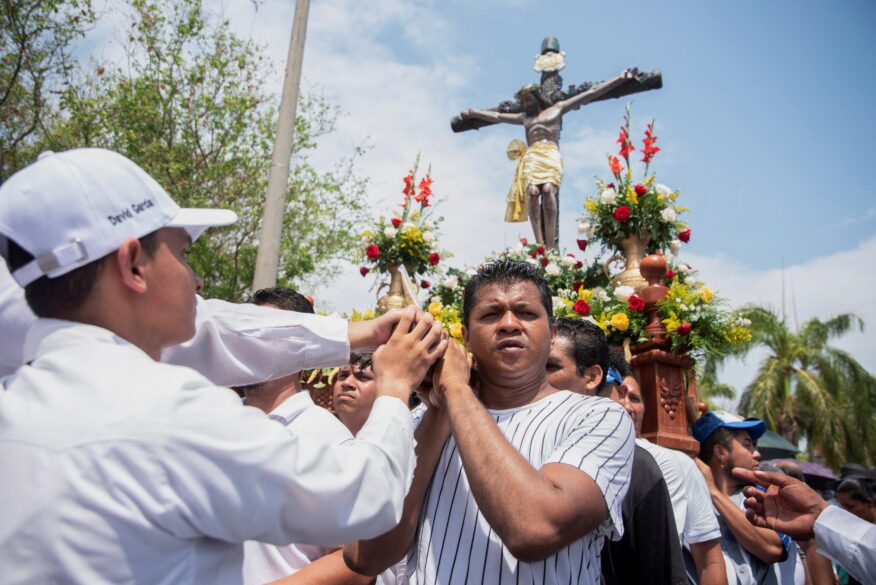
El régimen del presidente Daniel Ortega y su esposa, la vicepresidenta Rosario Murillo, ha reprimido todas las formas de disidencia y ha retratado a la Iglesia católica como un enemigo por sus intentos de encontrar una solución política a las protestas de 2018 que pedían el derrocamiento de Ortega y su posterior trabajo con las familias de los presos políticos. El obispo Rolando Álvarez de Matagalpa, que denunciaba periódicamente los excesos del régimen, fue encarcelado durante 500 días y exiliado al Vaticano en enero junto con otro prelado, el obispo Isidoro Mora de Siuna y otros 17 clérigos.
Posteriormente, el régimen ha moderado su discurso público hacia la Iglesia, según observadores, después de tachar a los líderes eclesiales de “terroristas” y “golpistas”.
Los pastores evangélicos también han sido perseguidos en Nicaragua. Once pastores afiliados a los ministerios Nicaraguan Mountain Gateway fueron condenados por cargos de lavado de dinero, dijo la organización en un comunicado del 28 de marzo.
Los pastores recibieron sentencias de entre 12 y 15 años de prisión y cada uno fue multado con 80 millones de dólares. Tres misioneros estadounidenses también fueron acusados, pero no estaban en Nicaragua en el momento de los arrestos de los otros pastores en diciembre de 2023, dijo Nicaraguan Mountain Gateway.
(David Agren escribe para OSV News desde la Ciudad de México.)
By Lorene Hanley Duquin
(OSV News) – Sometimes the words we use in Holy Week and Easter feel so familiar we don’t consider their origins. Same for the date of Easter, which changes from year to year. The following is a quick FAQ guide to Catholics’ Holy Week vocabulary and key history.
Q. Why do we use the word “Passion” to describe the suffering of Jesus?
A. The word “Passion” comes from the Latin word for suffering. When referring to the events leading up to the death of Jesus, we often capitalize the word “Passion” to differentiate from the modern meaning of the word with its romantic overtones.
Q. Why do some parishes cover the cross and statues during Holy Week?
A. Before 1970 it was customary to cover crosses and statues during the last two weeks of Lent. After 1970, the practice was left up to the discretion of each diocese. In 1995, the U.S. bishops’ liturgy committee gave individual parishes permission to reinstate the practice on their own.
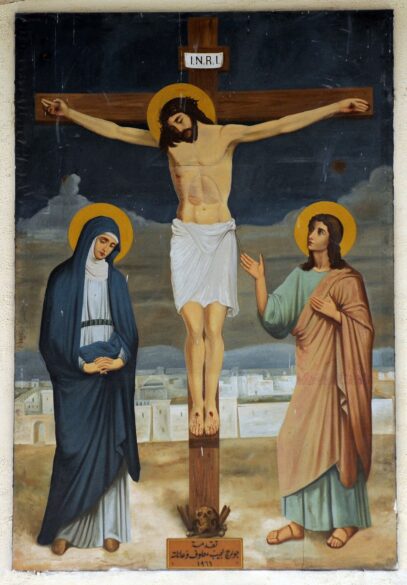
Q. What is Tenebrae?
A. The word “tenebrae” comes from the Latin word meaning “shadows” or “darkness.” It was originally the name given to somber parts of the Liturgy of the Hours that are chanted in monasteries on the last three days of Holy Week. The tone of the prayers is filled with sorrow and desolation. At various points during a Tenebrae service, candles are extinguished and there is a cacophony of noise, which evokes feelings of betrayal, abandonment, pain, sadness, and darkness associated with the crucifixion and death of Jesus. Parishes sometimes offer Tenebrae services during Holy Week.
Q. Why do we call it “Good Friday”?
A. In the English language the term “Good Friday” probably evolved from “God’s Friday” in the same way that “goodbye” evolved from “God be with you.”
Q. What is Pascha?
A. The word “Pascha,” or “Pasch,” comes from the Greek word for the Passover. The early Christians used the word to describe the resurrection of Jesus as the Christian Passover. Today, we sometimes refer to the death and resurrection of Jesus as the Paschal Mystery, which is derived from the word Pasch. Orthodox Christians still use the word Pascha when referring to Easter.
Q. Who decides the date of Easter?
A. In 325, the Council of Nicaea decreed that Easter would be celebrated on the Sunday following the first full moon after the spring equinox. It can occur as early as March 22 or as late as April 25.
(Lorene Hanley Duquin is a Catholic author and lecturer who has worked in parishes and on a diocesan level.)
By Maria Wiering
(OSV News) – A profound experience with the Eucharist during Mass in his freshman year at Texas A&M University compelled Charlie McCullough to make Jesus the center of his life.
“Every decision that I’ve made after that has been a small step in that relationship and a small response to that invitation,” said McCullough, a 22-year-old north Texas native. “And now the invitation is him saying, ‘Come and follow me,’ as we go on pilgrimage across the United States.”
McCullough is one of 24 young adults who will be journeying with Jesus in the Blessed Sacrament along four National Eucharistic Pilgrimage routes leading to the National Eucharistic Congress. The “perpetual pilgrims” will begin their treks May 17-19 – the weekend of Pentecost – from San Francisco; New Haven, Connecticut; Brownsville, Texas; and the headwaters of the Mississippi River at Lake Itasca in northern Minnesota.
Their routes – a combined 6,500 miles – will converge eight weeks later in Indianapolis for the July 17 opening of the five-day congress in Lucas Oil Stadium. Along the way, the pilgrims will go through small towns, large cities and rural countryside, mostly on foot, with the Eucharist carried in a monstrance designed particularly for this unprecedented event.
“This will be the biggest Eucharistic procession in world history,” said Kai Weiss, a perpetual pilgrim studying theology at the Pontifical Faculty of the Immaculate Conception at the Dominican House of Studies in Washington. “I think Jesus will sanctify this land in an unimaginable way, even invisibly and in an unseen way. But obviously, we will be visible and we will be easily noticed, and I just look forward to what Christ in the Eucharist can bring to other people.”
Weiss, 27, grew up in Regensburg, Germany, where elaborate Corpus Christi processions are commonplace, and people are familiar with Europe’s long history of walking pilgrimages, he said. Last year, he participated in a two-day walking pilgrimage to the Marian shrine of Our Lady of Altötting with about 4,000 people, where pilgrims sang hymns and prayed the rosary along the way.
“That really communal aspect is so beautiful about professions and pilgrimages – that they bring us together as a church, and that since they’re also public, they can also bring in other people,” Weiss said. “It’s a wonderful way of expressing our faith and our joy.”
The National Eucharistic Pilgrimage and National Eucharistic Congress are major parts of the National Eucharistic Revival, a three-year initiative launched in 2022 by the U.S. bishops to inspire a deeper love and reverence for Jesus in the Eucharist. The pilgrimage is modeled on the Gospel account of Jesus’ journey with two disciples to Emmaus after his resurrection.
In October, the National Eucharistic Congress issued a call for perpetual pilgrims and received more than 100 applications. Criteria included being a baptized and practicing Catholic between the ages of 19-29, be in good physical condition and capable of walking long distances, and be committed to upholding church teachings. Backgrounds in ministry, service, leadership and pilgrimage experience were of special interest, according to organizers.
The perpetual pilgrims were chosen after multiple rounds of interviews and follow-up screenings, organizers said in a March 11 media release announcing the pilgrims.
Most of the pilgrims are graduate or undergraduate students, and some work for mission-oriented apostolates and nonprofits. “A common thread for all was a profound encounter with Jesus in the Eucharist that they were inspired to share with others,” according to the media statement.
Organized by Modern Catholic Pilgrim, a Minnesota-based nonprofit that promotes U.S. walking pilgrimages and biblical hospitality, the pilgrimage routes include stops at sacred landmarks including saints’ shrines and diocesan cathedrals.

“I am humbled by the commitment demonstrated by those selected to serve as Perpetual Pilgrims this summer,” said Will Peterson, Modern Catholic Pilgrim’s founder and president, in a media statement. “Their excitement at serving as stewards of this unprecedented National Eucharistic Pilgrimage shook the walls at our kickoff retreat. I cannot wait for the rest of the U.S. Catholic Church to walk with our Eucharistic Lord alongside these amazing individuals.”
Each day will include Mass, a small Eucharistic procession and 10-15 miles of travel. Along the way, parishes are planning to host Eucharistic devotions such as adoration, praise and worship, and lectures. Parishes, religious orders, schools, shrines and retreat centers will offer the pilgrims hospitality and offer fellowship and meals.
A support vehicle will accompany the pilgrims and transport them through legs of the journey where “safety, terrain, and/or climate may present obstacles,” according to the media statement.
The pilgrimage routes are named for key saints for North America: the St. Elizabeth Ann Seton Route from the east, the St. Juan Diego Route from the south, the St. Junipero Serra Route from the west, and the Marian Route from the north, which includes a stop in Wisconsin at the Shrine of Our Lady of Champion, the only approved Marian apparition site in the United States.
Weiss is traveling the Marian Route with fellow perpetual pilgrims Sarah Cahill of Virginia; Matthew Heidenreich of Ohio; Danielle Schmitz of California; Jennifer Torres of Colorado; and Megan Zaleski of Illinois.
With McCullough on the Juan Diego route will be Camille Anigbogu of Texas; Shayla Elm of North Dakota; Issy Martin-Dye of Ohio; Joshua Velasquez of Texas; and MacKenzie Warrens of Missouri.
On the Serra route will be Chima Adiole of Texas; Chas Firestone East of Virginia; Patrick Fayad of Nebraska; Jack Krebs of Wisconsin; Madison Michel of Minnesota; and Jaella Mac Au of Georgia.
On the Seton route will be Dominic Carstens of Wyoming; Zoe Dongas of New York; Marina Frattaroli of Texas; Natalie Garza of Texas; Amayrani Higueldo of Pennsylvania; and Christopher Onyiuke of Florida.
Along the way, 30 Franciscan Friars of the Renewal will rotate time on the routes as chaplains. In addition, Father Roger Landry, a chaplain at Columbia University in New York, plans to accompany pilgrims on the Seton route.
As McCullough thinks about the people the pilgrims will meet along the way, he reflects on the way Jesus encountered people in the Gospels.
“It was always unique and different because he met them where they were at,” said McCullough, a college senior studying mechanical engineering. “I’m just so excited for the look of love from the Eucharist to be extended time and time again to whoever we encounter.”
Weiss said he thinks the National Eucharistic Pilgrimage could be a unifying balm in a polarized country.
“It’s him (Jesus) who brings us all together; he desires and yearns for all of us,” he said.
(Maria Wiering is senior writer for OSV News.)